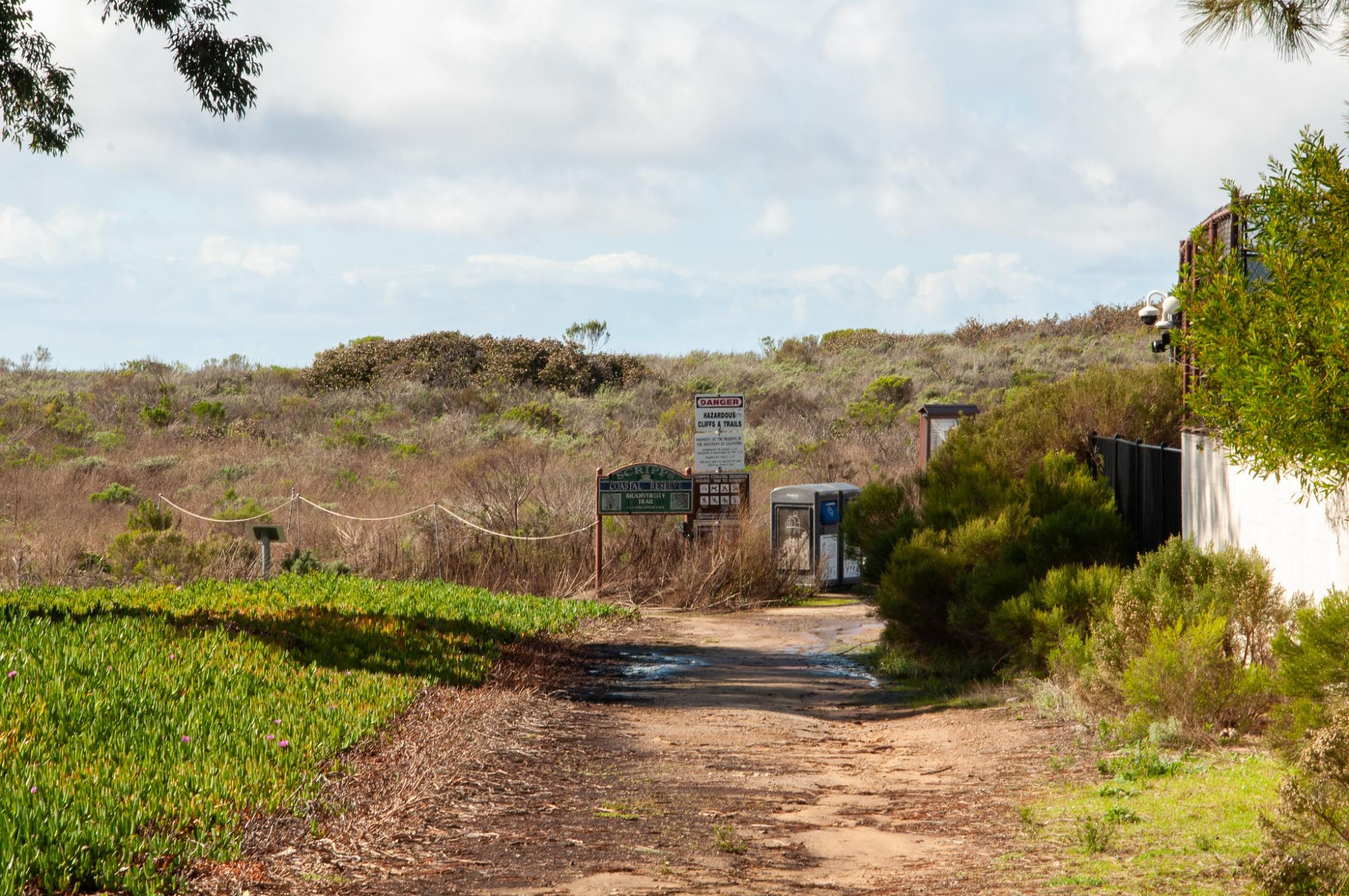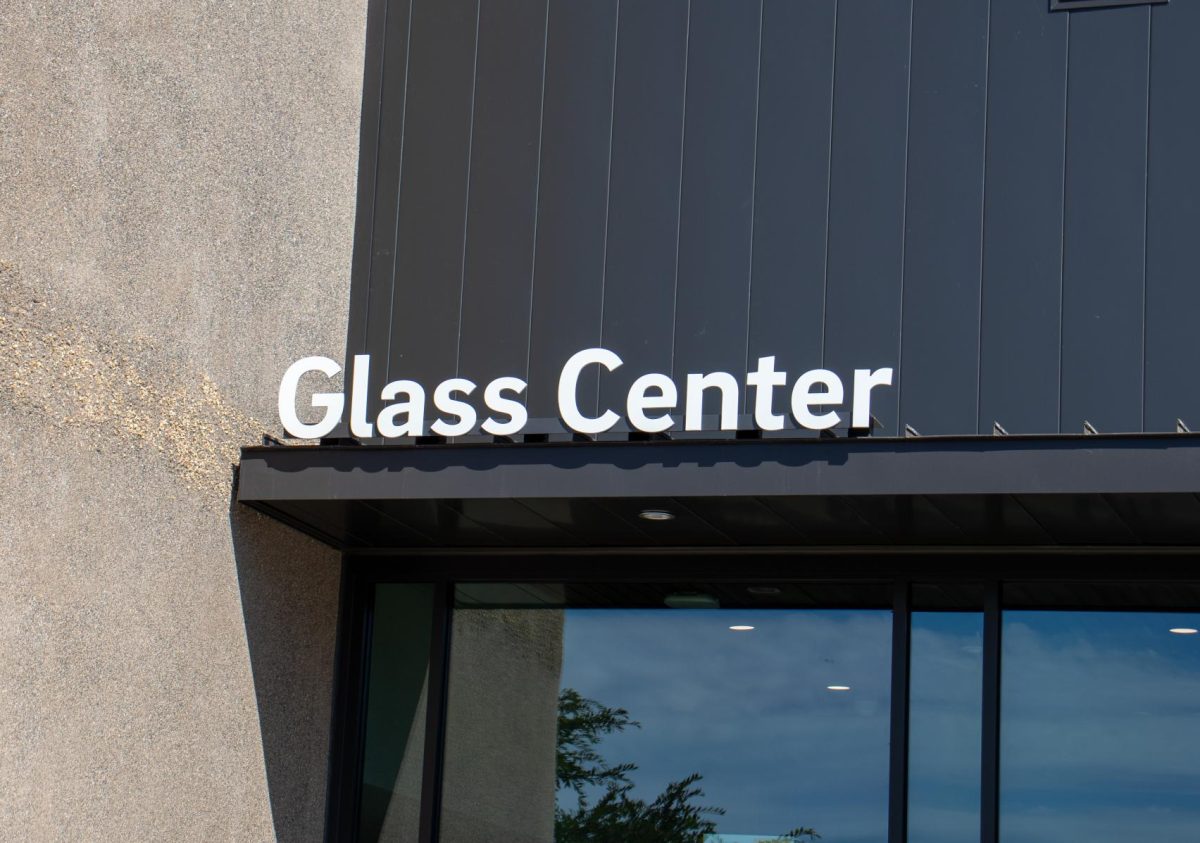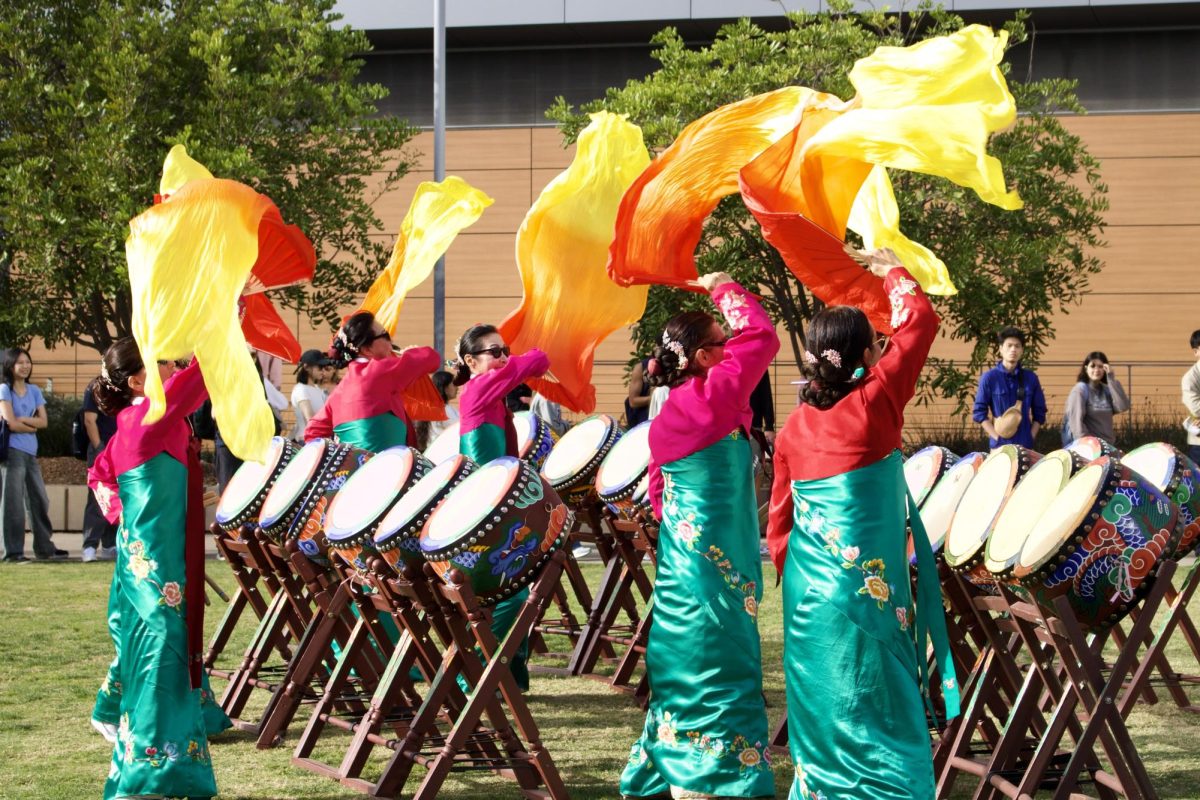The Scripps Coastal Reserve is a nearly-1,000 acre protected area in La Jolla managed by UC San Diego. The reserve contains a variety of habitats, including coastal canyon, bluff, sandy beach, rocky intertidal, mesa top, submerged coastal plain, and a deep submarine canyon. It is home to many rare and sensitive species.
Since the COVID-19 pandemic, the Scripps Coastal Reserve has implemented severe restrictions on public access to the site. Nearby residents have complained about the restrictions for the duration of time they have been in place. The California Coastal Commission is currently investigating the university’s actions due to complaints from the public that they have a right to access the reserve.
Controversy has surrounded the university’s closing off of a majority of public access to the site by placing temporary restrictions during the COVID-19 pandemic. In the university’s initial project narrative and request for a permit from the California Coastal Commission, the university sought to make these limitations permanent.
While access to the beach is still available via Blacks Beach Way, members of the public are only able to access the cliff and bluff areas above via docent-led tours offered on the first Saturday of each month from 9 to 11 a.m. The La Jolla Light has published several complaints about the docent-led tours, including one instance of a tour being postponed without any official notice apart from a piece of paper on the gate of the reserve.
The university’s basis for making the restricted public access permanent is that there has been a noted “improvement to the natural environment,” as Associate Director of University Communications Leslie Sepuka previously explained to The UCSD Guardian.
“The reduction of visitors is thought to have allowed sensitive wildlife to return to the reserve and has greatly aided [the] removal of invasive species that had disrupted native vegetation on the site,” Sepuka said.
The need to balance public access and necessary protections for wildlife in a reserve is not an uncommon problem in ecology. Professor of ecology Carolyn Kurle explained that the university has chosen the fortress conservation approach, wherein biodiversity protection is achieved by creating areas free or nearly free from human disturbance.
Kurle is an experienced conservationist both in practice and research, specifically focusing on marine conservation. She previously allowed her BILD 3 students to do an extra credit activity at the reserve, but had to stop that assignment in light of the new restrictions during the COVID-19 pandemic.
“[Fortress conservation is] used all over the place, and it’s only now kinda being examined as potentially short sighted and a little punitive,” Kurle said. “But on the other hand, if people are allowed to rampantly run around in a place you are trying to protect, that doesn’t work either because you are not actually conserving.”
Fortress conservation has been employed in reserves throughout the world, but as Kurle noted, there have been many critiques of this conservation practice. For example, one major critique of fortress conservation is that it alienates members of the public who are key to ensuring long-term sustainability in conservation goals.
“Intentions are good to protect species or wild places, but they forget to take into account [that] people are using that space for reasons that might not directly relate to conservation or that might even be antithetical to conservation,” Kurle explained. “It’s worth taking those needs into account.”
For many protected spaces, fortress conservation generally conflicts with and dispossesses local and Indigenous communities who live off of or use the land. Because fortress conservation necessitates the most limited human interaction with the protected ecosystem, it often displaces Indigenous communities who have lived on those lands for centuries.
Ironically, this displacement and alienation of local communities can be detrimental to the goals of conservation. This is because local communities can provide valuable insights into conservation, and having access to nature has been shown to increase positive attitudes toward conservation.
The issue of local cooperation rings true within the Scripps Coastal Reserve, with the university imposing these restrictions to the dismay of many members of the public. The disturbances caused to the local community by these restrictions are relevant, as Kurle notes that an important aspect of conservation is working with local communities.
“It would be a great opportunity and a great public outreach opportunity to work with these folks and find out what their desires are [to] see if UC San Diego could reach some sort of agreement with people,” she said. Kurle suggested ideas such as limiting access to only the daytime, increasing signage, and having more educational workshops as possible solutions.
The Scripps Coastal Reserve is just one of 41 reserves in the UC Reserve system, which provides a network of protected areas under UC management for conservation and research. While most of the reserves are closed to the public, the Scripps Coastal reserve was one of two reserves that previously offered year round public access.
Kurle has previously conducted research across the reserve system and emphasizes its importance.
“The UC Reserve system is amazing,” she said. “A lot of places have been donated to the university from private places, and they are now set aside for use with folks associated with the university to teach classes and do research.”
The idea that visitors caused detrimental effects on the reserve’s environment and disregarded rules is something that has been contested by local community members, many of whom have written letters to the La Jolla Light stating that they had not witnessed egregious rule-breaking of the reserve’s policies.
Kurle recognizes that public access could cause detrimental effects to the reserve and that there may be evidence of some people who ignored the rules. That said, she also believes in investigating alternative approaches to mitigate these harms instead of shuttering public access.
“What this place really is, is for teaching and for learning,” Kurle said. “If [anthropogenic harm] can be ameliorated by increasing signage and helping people understand what this place really is for … then we could try again to open it and remove some of that fortress conservation concept and allow the general public to appreciate and use the space.”
Residents of La Jolla have filed complaints to gain back access to the reserve with the California Coastal Commission, which is currently investigating UCSD’s request for a permit to continue restricting public access. The Coastal Commission has the authority to decide whether the university is allowed to continue keeping the reserve mostly closed.
In response to an inquiry from the Coastal Commission, UCSD submitted a 16-page document responding to questions from the Commission. In the document, the university noted that it considers its current policy on the reserve, to only allow research or “similar opportunities,” to be the best option.
“[The current restrictions] best prioritize the ecological function and cultural sensitivity of the Scripps Coastal Reserve and mission of the UC Natural Reserve System by eliminating the human-caused degradation,” the document reads. “In addition, public access is not necessarily congruous with the SCR’s research mission. The SCR is an outdoor laboratory where important university research occurs, and unmanaged public access can be detrimental to ongoing research at the SCR.”
Kurle responded directly to a comparison the university made between the university laboratories being restricted to public access and the restrictions put in place with regards to Scripps Coastal Reserve.
“[It] is an interesting point, except that we are a public university funded by public money … It could be interesting to explore ways in which the public could have access to things like the Scripps Coastal Reserve to make them see where their taxpayer dollars are going,” she said.
For her part, Kurle commends the decision of residents to go through the Coastal Commission.
“It’s clear, even if it might be the right thing to do for UC to shut off access, they didn’t go through the proper channels by which to do that, and it’s unfortunate because it makes the university look heavy handed and dictatorial, and it creates animosity with our neighbors,” Kurle said.
Ultimately, the balancing act between total fortress conservation and unfettered public access is a nuanced issue. That said, Kurle believes in the importance of having all people connect with nature.
“We know there are really strong data demonstrating that when people feel a personal connection to nature, they are more apt to want to conserve nature. It has been shown in so many studies,” she said. “Any time you let people experience nature, it is a bonus for conservation.”









Martin • Jun 30, 2024 at 3:45 pm
I don’t know why you have this impression of the local residents. We also have lost access to something that we cherished as much as anyone. I’ve lived in this neighborhood for decades and used to walk on these trails almost daily. The view from the blufftop is part of what sold us on moving here, and I loved seeing families and UCSD students come to enjoy the sunset together. If anything, closing the Knoll just sends people deeper into the neighborhood to access other viewing spots.
The illegal closure is not in fact driven by neighboring property owners but by Isabelle Kay and the other UCSD Natural Reserve System staff. We have been pushing back against the illegal closure through the proper channels and raising awareness by writing to the local news. You say the opposition has not been driven by us, but by non-resident alumni. What have they done that we should be doing? Why don’t they want our support when we want the same thing?
You say “this is much more a UCSD students issue than a La Jolla issue?” UCSD students are part of La Jolla, and most of us locals have at least one UCSD degree in our families. I appreciate your opposition to the illegal closure, which I share, but please don’t mischaracterize the local residents as the enemy when we’re just as upset as anyone else.
Frank • Jul 29, 2024 at 12:01 pm
Dear Martin:
I can understand why you think that the closure was driven by Isabelle Kay because that is what our network of activists all thought as well when we started our work on this. But when UCSD themselves, with direct review and approval of the application by Chancellor Khosla, applied to keep the Knoll permanently closed then we knew it had to go deeper than just Isabelle’s rogue action. Several public records requests were submitted to UCSD and the trove of documents received paints a very different picture. It is very well documented through official letters on UCSD letterhead and an extensive collection of emails that the parties driving the illegal 2012 gate installation, the illegal 2020 closure, and other Coastal Act violations have, in fact, been neighbors. These communications involve the chancellor, vice chancellors, and other high-ranking UCSD officials.
The documents clearly show that the push for these Coastal Act violations came from two neighboring interests: Scripps Estates Associates and La Jolla Farms. SEA’s interest was in restricting public access to a historical trail from the Knoll to Black’s beach via Sumner Canyon. The 2020 closure allowed them to accomplish this, and Isabelle Kay subsequently blocked the trail. This makes this historic beach trail the private beach trail of SEA. This was done by SEA collectively, not individual homeowners. They even have a legal agreement with UCSD that gives them extensive power over the reserve. This is fully documented and is central to the Coastal Commission’s case. La Jolla Farms’ interest is more complex, as there have in fact been a significant number of Farms residents, such as yourself, who have been angered by the closure because they used the Knoll so much. The Coastal Commission has stated that many of the complaints that they have received came from Farms residents. Yet the public records obtained from UCSD reveal something very different. There is extensive involvement in the Coastal Act violations by the gate’s neighboring property owners, especially Ron Kagan who is the President of the La Jolla Farms Security Association, which was responsible for the (illegal) gate’s (illegal) daily unlocking and locking from 2012 to 2020 and has a well-documented history of restricting public access to Farms in general (related to public parking spaces illegally painted red). The communications obtained between these neighboring interests in La Jolla Farms and Scripps Estates Associates and the University are literally hundreds of pages long and incredibly explicit.
While you may think that UCSD students are part of La Jolla, that certainly isn’t a sentiment shared by the overwhelming majority of UCSD students and UCSD graduates who don’t have family connections to La Jolla. And you are certainly well aware that the reserve was used primarily by students if you visited there frequently. You wrote: “We have been pushing back against the illegal closure through the proper channels and raising awareness by writing to the local news. You say the opposition has not been driven by us, but by non-resident alumni. What have they done that we should be doing? Why don’t they want our support when we want the same thing?” First, I don’t know what you think the “proper channels” are, but the only one that matters is the California Coastal Commission as they are the ones assessing UCSD’s closure and retroactive gate approval application according to the California Coastal Act and will be determining the legal outcome. Our network of volunteers has spent literally thousands of hours working on a completely volunteer basis, assisting the Coastal Commission by providing them with evidentiary documents that form the basis of their case. The Coastal Commission has no interest in “I went there for decades and want it reopened because…” emails, only actual evidence that applies to the California Coastal Act. If you aren’t working on providing them the evidence they need for their case, you haven’t done anything real. All of the volunteers working on this are UCSD alumni and none live in the Coastal Zone. Most don’t even live in San Diego County but just love the place because it was central to our college experience and we want present and future students to enjoy it as well. We have reached out extensively to La Jolla Farms homeowners and have gotten ZERO assistance. You are also not telling the truth about “writing to the local news.” We have tracked the dozens of letters published in the La Jolla Light and not a single one has come from Farms. Not one. Two letters have come from a SEA homeowner, David Amitai, who wants the reserve to stay closed (the only letters opposed to reopening).
As I am sure you are well aware, La Jollans frequently sue to fight projects they don’t like. I am sure you are aware of the long Hillel building saga. So why haven’t the Farms residents sued to have the Coastal Act violations enforced as they legally could? Or at least provided some funding to the volunteers spending thousands of hours doing all of the work for you? You and all others you know in La Jolla Farms can also email the Office of the Chancellor, state that you are a La Jolla Farms homeowner (UCSD cares tremendously about this due to the prevalence of big-money donors in the neighborhood), and demand that the reserve be reopened AND that ALL donations to UCSD will be withheld until it is reopened. Write letters to the La Jolla Light encouraging other significant donors to suspend donations. These are real actions you can take. But please don’t make it sound like La Jolla Farms opposes this closure while non-local UCSD alumni volunteers are spending all of their free time actually working on this and exposing the deep involvement of neighbors in UCSD’s Coastal Act violations.
Martin • Sep 1, 2024 at 12:17 pm
Thank you for the work you and the other volunteers have done. I’m grateful for the time you’ve spent, it’s a special place.
You asked why the Farms residents haven’t sued the Coastal Commission and made demands to the Chancellor, and funded your volunteer efforts.
First, I have never been contacted by you or your fellow volunteers. I have never seen any information about you or your group in the various fora where this is discussed, including the La Jolla Light. I have never seen your group around the Knoll, and I’ve heard nothing about your advocacy from the Security Association. The evidence you’ve collected has not been made publicly available anywhere that I’m aware of.
Second, we’re not a monolith, so I can only speak for myself and speculate about my neighbors. Many of us spent years jumping through hoops to appease the Coastal Commission in order to live here. An aggrieved Commission employee could easily make our lives hell. Many of us have built careers at UCSD, or have family who have done so. In sum, we have a lot to lose.
Still, maybe I would bring suit if I had the evidence you reference, but why haven’t you? I don’t have any special rights or claims, nor do I have thousands of hours to gather evidence. But you’re convinced the Coastal Commission is on your side and the locals aren’t… Ask yourself, hasn’t the CCC received enough evidence of UCSD’s dishonesty and the illegality of the closure? It’s been four years and the CCC hasn’t held a single public hearing about it. They could have the gate open in an hour if they wanted. How many more 45-day reprieves do you think the CCC should give Isabelle Kay to produce a CDP application with lies plausible enough to withstand scrutiny? Another year while we all spin our wheels?
By the way, I did write to the La Jolla Light and I was ignored. Thanks for calling me a liar. Given all this, I’m not sure what you’re expecting. Should I empty my bank accounts and light my house on fire? If I leave a barrel of cash marked “Frank” by the gate, will I – a mere local alumnus – be worthy of my non-local alumni betters?
Frank • Sep 19, 2024 at 9:47 am
Dear Martin:
First, the Coastal Commission is not the one to be sued. It is the Regents of the University of California, the primary violating party, as well as their coconspirators in Scripps Estates Associates and La Jolla Farms. The Coastal Commission is not the one violating the law; these parties are.
I hope that you can understand why, given La Jolla Farms involvement in these violations, we have been hesitant to go door to door and request assistance. We have reached out through multiple trusted La Jolla Farms homeowners that one of the group of volunteers personally knows through surfing at Black’s Beach, and these Farms homeowners have reached out to other likeminded homeowners. And the responses have always been similar: We really appreciate what you are doing but we can’t get involved ourselves, both because we are too busy and because we don’t want to create division within the neighborhood. And we also aren’t willing to give you any funding for the amount of work you are doing and lost wages you are incurring as a result.
And yes, you were untruthful. You wrote “We have been pushing back against the illegal closure through the proper channels and raising awareness by writing to the local news.” What “proper channels” have you been pushing back through? The California Coastal Commission is that proper channel, and as you say, you are unwilling to get involved with them. And if your letter to the La Jolla Light wasn’t published, you have not been “raising awareness” in anything other than your own mind. Our volunteers also had every letter that they have submitted published, so I find your claim difficult to believe. So again I repeat, you have done nothing but make excuses for why you have done nothing.
Of course you have never seen our group around the Knoll; the Knoll is closed! We don’t live in La Jolla Farms like you do and don’t meet at the locked gate. We are doing our work from our own homes. And much of the evidence has been made public by the Coastal Commission in their most recent letter to UCSD, which you can request from CCC as it is a public document.
Oh, how sad that the residents of La Jolla Farms have “a lot to lose” by taking meaningful action. You don’t think the same is true for us, with many of our volunteers being personally harassed and threatened, including by some of your neighbors in La Jolla Farms?
You wrote “Still, maybe I would bring suit if I had the evidence you reference, but why haven’t you? I don’t have any special rights or claims, nor do I have thousands of hours to gather evidence.” Um, maybe because we don’t have the money to file a lawsuit because none of us are filthy rich like the people of La Jolla Farms are? That is why we have been working with the Coastal Commission, who has their own attorney working on the case. And you don’t have the time to gather evidence, but we do? We aren’t rich and yet many of us have reduced our employment to work on this. Our most active member is literally dying from cancer and is devoting his final days to working on this so that future UCSD students can again go there again and that access is permanently protected. And you don’t have the time??? Yes, because you need to make the money to live the high life in La Jolla Farms. Obviously, your time is far more important than the time of our lowly volunteers in Buena Park and Corona giving up their family time to work on this, in addition to working fulltime jobs where they get paid less in a week than many in La Jolla Farms make per hour.
Your comments on the Coastal Commission reflect your lack of understanding of their work. No, they could not “have the gate open in an hour if they wanted.” They are bound by the law and the legal process is very slow. They are so underfunded that they literally only have 2 lawyers for the entire state working on Coastal Act violations. For the entire California coast. A private lawsuit could have made this process go dramatically faster. Many Coastal Commission cases go on for decades. This one has actually been remarkably fast so far due to the extreme amount of assistance from volunteers. And CCC has not been giving UCSD any “45-day reprieves”. The process has gone on this long because there have been so many additional Coastal Act violations found during the back-and-forth process, which the Commission will use as leverage against both the university and neighbors in order to make the reopening permanently protected and with enough potential fines to discourage appeals from any parties. And the CCC doesn’t have public hearings about ongoing Coastal Act violation investigations. After UCSD’s application is filed as complete, this will go to a public Commission hearing. You clearly do not understand how the Coastal Commission works and how much time they are devoting to getting this permanently resolved.
And lastly, we do not see ourselves as any better than anyone else, but also not any worse just because we don’t have the wealth that you and your neighbors do. Just don’t claim that you and your neighbors have been doing anything about this situation while we are spending an extreme amount of our own time and subjecting ourselves to threats to do the work that you are unwilling to do, but will gladly take credit for when the Knoll is reopened.
Martin • Sep 29, 2024 at 12:15 am
I was in the early stages of preparing a lawsuit, and I know who the appropriate parties are to sue (yes, the Coastal Commission would need to be a party in the case). You have single-handedly dissuaded me from continuing. I probably would have helped support your efforts too, I was looking for stakeholders to collaborate with. But for all your efforts, you’d (ironically) rather gatekeep the effort to remove the gate and whine about how you chose to devote time to the project. Okay.
You tell me you spent thousands of hours, I thanked you for it, said I don’t have thousands of hours to spend, but hey you’ve already done some work and I have other resources so maybe it’d make sense to combine efforts. And you come at me with that ridiculous screed?
You can’t even understand what I”m saying because you’re so consumed by your ignorant prejudices against my neighborhood. You asked me why none of us had filed a lawsuit, I speculated concerns that might be unique to people in the neighborhood (like you asked) and you reply: “Oh, how sad that the residents of La Jolla Farms have “a lot to lose” by taking meaningful action. You don’t think the same is true for us…”
I haven’t made any assumptions about you and your group–I thanked you and tried to find common ground. You’re arguing with your own projections, which seem to matter more to you than getting the gate removed.
Hey, let’s tweak out for another 100 posts about when I said “proper channels!” Proper channels!? But you’re the only proper channel!! Are there other channels?! Proper channel! What channel!?! Is a person a channel?!? Oh boyyy!!!
I won’t bother trying to explain what you’ve got wrong because you obviously just hate me and my neighbors regardless. I know you think you know how all of this works, but your group needs its own attorney if you want your time to be spent more effectively. Some would take the case pro bono or on contingency fee basis. Maybe not if you’re foaming at the mouth.
Best of luck
John • May 28, 2024 at 8:48 am
Another case of affluent property asserting their interests over the protection of ecological and cultural resources for future generations. Using a state agency to fight for a nice walk behind your house (rather than walking further down the street) is the height of privilege, especially when there are POC and tribal communities that could use the attention of the coastal commission in far more significant access issues.
Frank • May 30, 2024 at 2:23 pm
It is actually the opposite. The closure itself is being driven by the neighboring property owners who want to privatize a beach access that has been used by the public since 1956 (long before UCSD owned it) and they have used their power and influence with the university, itself a state body, to accomplish their goal, in clear violation of the California Coastal Act.
The opposition to this illegal closure has not been driven by La Jollans as most want people out of their neighborhoods. It has been driven by UCSD alumni who came to love nature at this place. The overwhelming majority of public access users were UCSD students, not La Jollans. The confusion is that many of these people have written to the La Jolla Light because they have been covering it, but this is much more a UCSD students issue than a La Jolla issue.
And oh yeah, check out UCSD’s record on protecting Kumeyaay cultural resources for future generations. UCSD has used the reserve for digging up human remains at free will as the reserve is for research and education. Maybe ask the Kumeyaay how they feel about UCSD, or simply search Google for it.
The reserve has also improved dramatically in ecological condition over the decades before the closure, and volunteer restoration work has decreased dramatically since 2020. The aerial photos prove this pretty well. This closure had nothing to do with either ecological protection or the Kumeyaay. It is corrupt and illegal to the core.
It’s really sad that UCSD has so successfully lied to people and that UCSD students don’t understand what an incredible place they are missing out on for the interests of the ultra-rich neighbors.